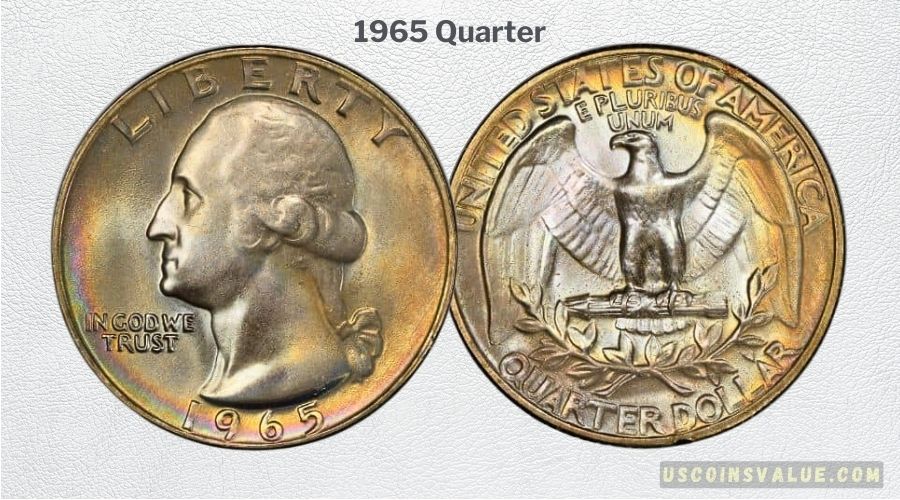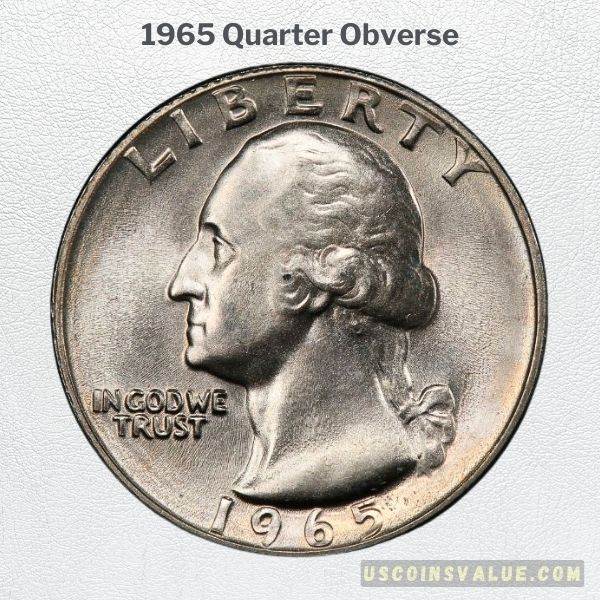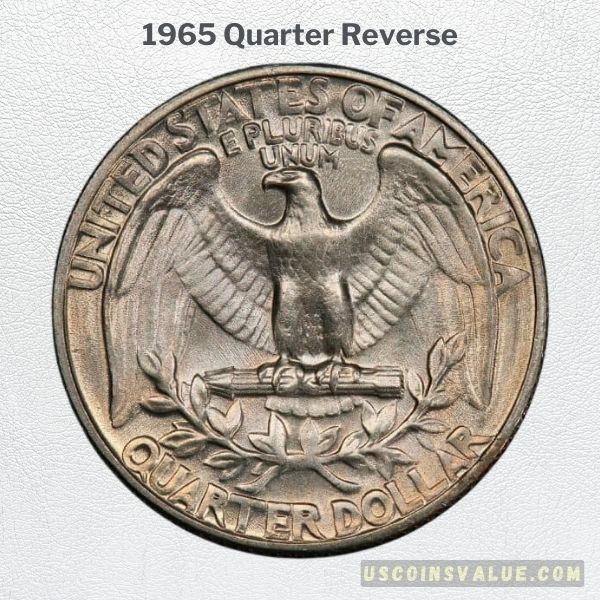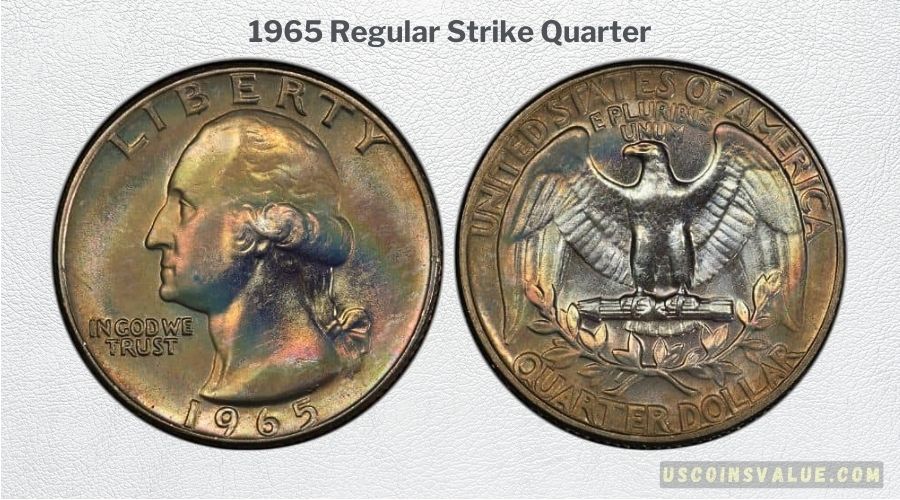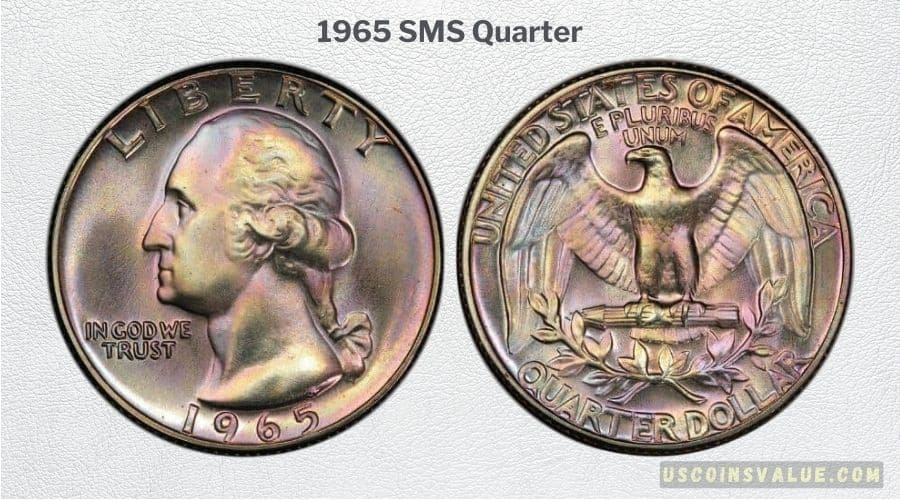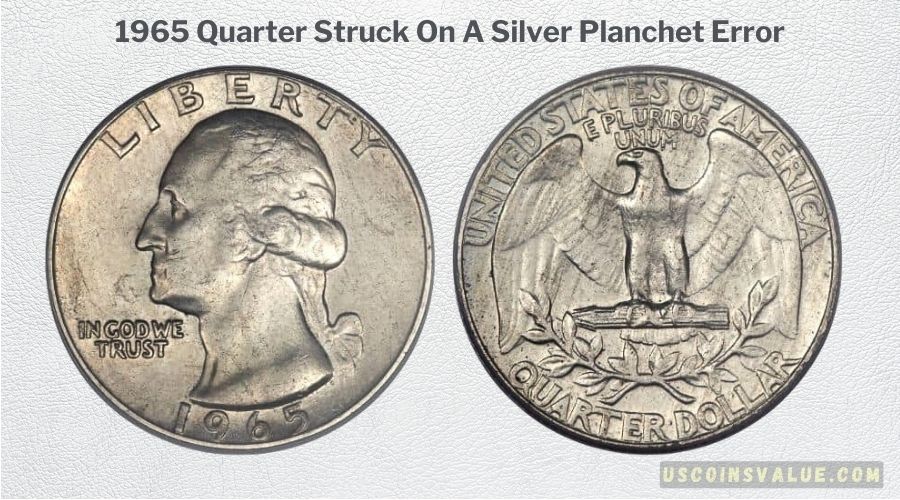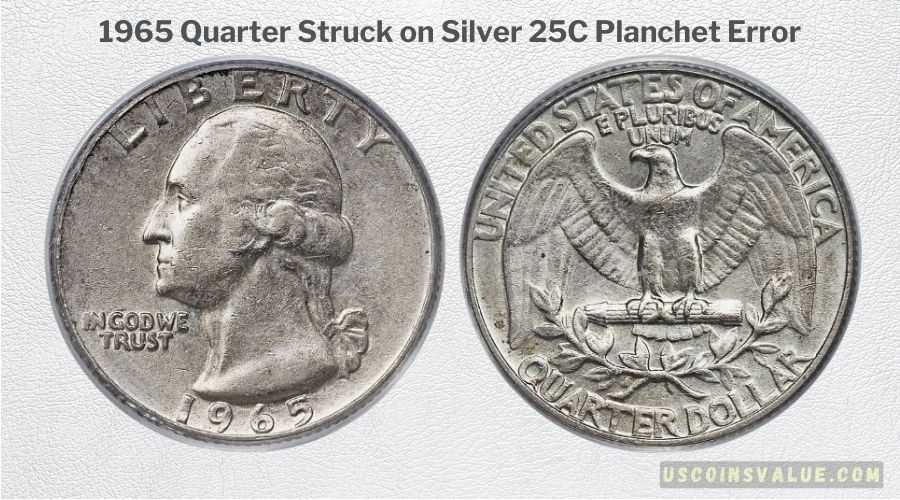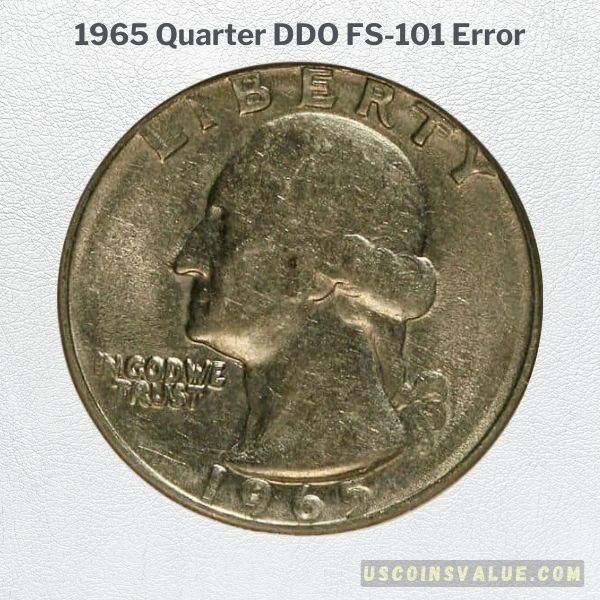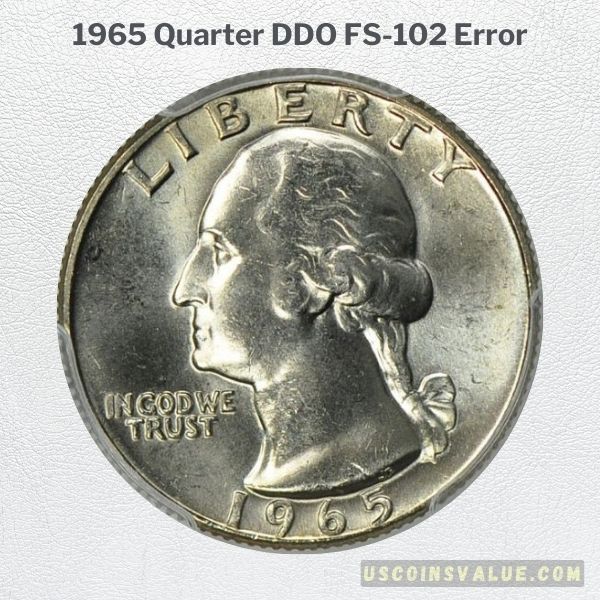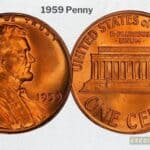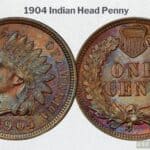1965 is the year when the U.S. Treasury switched from making 90% silver coins to clad composition coins like this 1965 Washington Quarter. Made during a transition period, these quarters are among the few U.S. coins with valuable rare transitional errors.
The face value of a regular 1965 Washington Quarter in circulation is between $0.30 and $0.85. The open market prices of these 1965 Quarters start at $8 for the common lower grades but can go as high as $5,000 if the coin is of the highest grade and/or features a rare mint error.
Read on to dive into the various aspects of the 1965 Washington Quarter. Learn of the various rare quarters in the series, the history behind it, mint errors, distinctive features, various varieties, and the factors that contribute to its worth.
History of the 1965 Quarter
1965 Quarters are part of the 1932 – 1998 George Washington Quarter Series of coins made to commemorate the 200th Anniversary of Washington’s birth. The obverse features Washington’s images, and the reverse depicts an olive stalk, a bundle of arrows, and an eagle with wings spread.
The unique history of these coins ties into one of the most strategic decisions ever made by the U.S. Treasury – switching from silver coins to clad coins.
1965 Quarters were made during the 1964 – 1965 Transition Year when the U.S. Mint was transitioning from making silver quarters to copper + nickel clad quarters.
The transition was necessary because the United States was experiencing a higher demand for silver due to its price rise between 1963 and 1964. Silver supply was going down, which made it challenging to mint more coins.
The U.S. Treasury later realized that since the coins were becoming more valuable than their monetary value, many citizens started collecting the silver coins instead of circulating them through commerce. People melted the silver down into bullion and sold them for higher returns.
Hoarding of the silver coins meant that the face value increased while still declining the circulation value of the coins. This made it harder for the U.S. Mint to create silver coins at an effective rate, leading to the decline in silver coin production between 1963 and 1964.
By 1965, the silver consumption rate was more than double the new silver production rate. A change was needed, and to solve this, the only course was to reduce the dependence on silver in the making of coins.
The solution came in the form of a new bill signed in 1964 bill by President Lyndon Johnson to create clad composition coins. These coins would use a composition of different metal layers instead of one silver layer, and in this case, it was the use of an Inner Pure Copper Core and an Outer Nickel-Copper Layer.
The Coinage Act of 1965 was implemented to change silver coin practices that had existed since the Act of 1792, 173 years prior. The Act eliminated silver from the circulating United States quarter dollar coins completely.
The U.S. Treasury chose a clad composition of 75% Copper and 25% Nickel to make the new clad coins for the 1965 Washington Quarters.
By 1965 Summer, the new clad coins entered circulation, and since they were much cheaper, people did not hoard them. After that, the clad composition formula was used to create coins that would not affect supply and demand during their circulation.
1965 Quarter Features
Below are the summary characteristics of the 1965 quarter:
| PROPERTIES | DETAILS |
| Year of Make | 1965 |
| Type | George Washington Quarters |
| Years of Issue | 1932 – 1998 |
| Varieties | 1965 (Regular Strike) Quarters – No Mint Mark
1965 SMS (Special Strike) Quarters – No Mint Mark |
| Mint Branch Facility | · Philadelphia (P) |
| Mintage (How Many Made) | 1965 (Regular Strike) Quarters: 1, 819 717, 540
1965 SMS (Special Strike) Quarters: 2, 300, 000 |
| Designer | Obverse & Reverse: John Flanagan |
| Metal Composition | 75% Copper, 25% Nickel over a pure Copper center |
| Face Value | $0.30 – $0.85 |
| Edge | Reeded |
| Diameter | 24.30 millimeters |
| Weight | 5.67 grams |
| Highest Auction Records | 1965 (Regular Strike) Quarters: $12, 650 – 2005 Stack’s Auction
1965 SMS (Special Strike) Quarters: $5, 175 in MS63 Grade – 2006 Heritage Auctions |
1965 Quarter Varieties
There are only two varieties of the 1965 quarters, and both were minted in the Philadelphia (‘P’) Mint:
- 1965-P (Regular Strike) Quarters – No Mint Mark
- 1965-P SMS (Special Strike) Quarters – No Mint Mark
Both were made in Philadelphia, but some speculate the SMS variety was made in the San Francisco Mint. Since they do not bare any Mint Marks, it is hard to know which mint facility is the right one.
Regardless, these two varieties were made for different purposes. The 1965 Regular Strike was for normal circulation, while the 1965 SMS quarters were made for collectors.
SMS (Special Mint Sets) was made with specially sandblasted dies that struck the coins creating a smoother satin-like finish. They are brighter and shinier with a higher quality appearance.
Obverse and Reverse Design
The obverse (heads) features George Washington’s image facing left- designed by John Flanagan. Inscriptions include the proclamation:
- LIBERTY – above the image of Washington
- IN GOD WE TRUST – on the left of the image
- 1965 – below the image
The reverse (tails) was also designed by John Flanagan. The design depicts the image of an eagle standing on a bundle of arrows with wings spread and two olive sprays beneath it all. Reverse inscriptions include:
- UNITED STATES OF AMERICA – curved on the top side
- E PLURIBUS UNUM – A motto that translates to “Out of Many, One” appears inside the concave set over the eagle’s head
- QUARTER DOLLAR – curved below the olive sprays
What Makes the 1965 Quarter Rare?
The rarest 1965 quarters are those that feature the transitional error – the 1965 Silver Quarter. Other rare varieties in the 1965 quarters include coins with mint errors, such as the DDO errors and Struck on Wrong Planchet Errors.
Apart from all of these errors, 1965 quarters are worth a lot of money if they are of the highest grades.
1965 Quarter Grading System
The Sheldon grading scale is the industry standard for coin grading, where a coin’s condition is scaled from 1 to 70. This is the scale used by notable grading services like PCGS and the Numismatic Guaranty Company (NGC).
The scale is divided accordingly, and in the case of the 1965 Washington Quarter, there are three categories to look for:
- MS (60 – 70) – stands Mint State and used to show condition of circulation coins from grades 60 to 70.
- PF (60 – 70) – stands for Proof and is used to show grade of Proof coins from grades 60 to 70.
- AU (50 – 58) – stands for About/Almost Uncirculated and is used to show grade for uncirculated coins that pose slight wears on the highest points of the coin.
Please keep in mind that grading standards vary from type to type and you may want to check with a detailed coin grading tutorial or professional.
A scale of 70 (e.g. MS70 or PF70) means that the coin has no post-production imperfections when you magnify the coin at 5x the magnification. A low grade (say MS63 or PF63) shows the coin has average strikes and weaknesses with moderate abrasions and hairlines in varying sizes
In 1965 Washington Quarters, MS64 grades and lower are considered common. MS65 is scarcer but not scarcer than MS66 which are said to be less than a few thousand in existence. MS67 is very rare with less than 50 known coins in existence.
Only a handful of MS68 coins have ever been graded in history. These coins are the rarest grade and are estimated to cost $20,000 in the open market.
Colors of the coins are used as suffixes to show how well the coin has been protected from external chemical reactions.
Red (RD) means the coin has been sealed and well protected while Brown (BN) means the coin is in the poorest condition and has been highly circulated. Red and Brown (RB) is a mid-condition coin.
1965 Quarter Value
Below is a summary value chart of the 1965 Quarter varieties and how they are valued according to PCGS:
| 1965 Washington Quarter (Price Guide) For Various Grades | 1965-P (Regular Strike) Quarter | 1965-P SMS (Special Strike) Quarter |
| 63 | $8 | $10 |
| 64 | $14 | $12 |
| 65 | $22 | $16 |
| 66 | $40 | $20 |
| 67 | $375 | $35 |
| 68 | $20, 000 | $100 |
Note: The grades (63 – 68) represent the particular coin’s grading prefix, i.e. MS63-MS68 and SP63-SP68 SMS pennies.
Let’s see how much each 1965 quarter is valued:
1. 1965 Washington (Regular Strike) Quarter Value
The regular strike 1965 quarter is valued by NGC starting from $1.50 for the MS60 grade, $2.50 for MS61, $3.50 for MS62, $5 for MS63, $7.50 for MS64, $10 for MS65, and $30 for MS66.
These are the most common grades you will find these coins at anything from MS67 and above is considered rare and valuable.
MS67 starts at $375 valuation, and most coins at this grade sold at auctions for $204 in 2020, and $156 in 2019.
MS68 are the highest recorded grade conditions for the Regular Strike 1965 quarters. PCGS has only graded one of its kind, while NGC has graded 15 of them, one with an astounding MS68+ rating.
The price estimation on PCGS is $20,000, while NGC places a historical price guide of about $5,250. However, none has ever gone on sale or auction, so we are yet to see the price they will realize due to their rarity.
Below are the highest historical auction records for the 1965-P (Regular Strike) Quarters:
| Grade | Price | Auction | Sale Date |
| GEM BU * | $12, 650 | Heritage Auctions | 2006 |
| MS68 | $1,920 | Heritage Auctions | 2019 |
| MS68 | $1, 825 | eBay | 2021 |
| MS68 | $1, 680 | eBay | 2023 |
| MS68 | $1, 340 | eBay | 2021 |
Note: * – GEM BU stands for GEM Brilliant Uncirculated – is used by collector/dealer to describe coins with a grade of at least 65. It is used as a synonym for Mint State or Proof State for brilliant uncirculated coins.
2. 1965 Washington SMS (Special Strike) Quarter Value
1965 SMS (Special Mint Set) coins were created for commercial sell to collectors and the public. A complete set sold for $4.00 and included special finish 1965 quarter coins with shinier and brighter looks.
Unlike circulation coins, SMS coins come in Red if they are of the lowest quality, Cameo in mid-conditions, and Deep Cameo in the highest-grade conditions. Red 1965 SMS coins are the most common in the open market and are priced at less than $100.
Auction prices for SP67 grades range between $16 and $30 while SP68 grades can cost more than $300. In rarer cases, the SMS coins can sell for thousands of dollars depending on demand.
Below are the highest historical auction records for the 1965-P (Special Strike) SMS Quarters:
| Grade | Price | Auction | Sale Date |
| SP68 | $4,025 | Heritage Auctions | 2011 |
| SP68CA | $2, 640 | Heritage Auctions | 2018 |
| SP68CA | $1,880 | Heritage Auctions | 2017 |
| SP68 | $1, 234 | Goldberg Auctioneers | 2015 |
| SP67 | $805 | Goldberg Auctioneers | 2008 |
1965 Quarter Error
Below is the short 1965 quarter error list showcasing the rarest major errors with descriptions:
1. 1965 Quarter Struck on a 90% Silver Planchet
- Mint Error: Rare Transitional Alloy Error: Struck on a 90% Silver Planchet
- Weight: 2 grams, plus or minus 10%
- Auction Record: $14, 687,50 AU58 grade sold in 2014, $7, 800 in AU53 grade in 2021, $8, 400 in AU58 grade in 2019 , and $5, 462 in XF45 Grade in 2010 at Heritage Auctions
The above error is a transitional alloy wrong planchet error. Planchets are the blanks on which dies are struck to create coins.
Transitional Errors essentially are errors that occur when a coin is struck on a planchet meant for the previous year (made of a different metal composition) or when the dies used in the coin production are meant for the previous year.
A few 1965 quarters were struck on silver planchets left from the 90% silver 1964 quarter production.
During the transition from silver to copper-nickel clad coins, the U.S. Mint produced both silver and copper-nickel quarters for some time in 1965 and early 1966.
The silver quarters were dated 1964 instead of their proper year of production. Only the copper-nickel quarters were dated properly with their respective years.
As you may expect, a mistake happened where some of the old 90% silver planchets from 1964 productions got stuck in the 1965-coin bins that the mint used to make the copper-nickel coins. The result of this was the 1965 silver quarter seen above and other coins of the same kind.
1964 quarters used the 90% Silver planchets weighed at 6.25 grams, give or minus 10%. This mass is very important in identifying true transition errors since the metal composition of a coin affects its weight.
Therefore, coins with this error will weigh more than the 5.67 grams which is the expected mass of a standard 1965 Quarter.
You can find these coins on eBay for about $2,400.
2. 1965 Quarter Struck on Silver 25C Planchet Error
- Mint Error: Transitional planchet Error: Struck on Silver 25C Planchet
- Grade: XF45 (above coin grade)
- Weight: 2 grams, plus or minus 10%
- Auction Record: $9, 300 in 2022 at Heritage Auctions
This is the second type of transitional error – the use of previous year’s dies with different metal composition.
In 1965, the quarters were supposed to be manufactured with clad composite planchets (copper-nickel clad) rather than the previous year’s single Silver metal planchet.
Due to the transition from silver to clad coins, some silver planchets consisting of 90% silver were accidentally left on the production line. This led to the creation of 1965 Washington Quarters made of silver when the dies struck on silver planchets instead of clad planchets.
So, how do you tell if a 1965 quarter is silver?
The 1965 clad coins still featured a silvery look which made it harder to distinguish them from the real silver coins. However, one key design difference made it easier to separate the two apart– the reeded edge color.
Both the Regular 1965 clad Quarters and the 1965 Silver Quarters featured reeded edges. However, on the clad coin the edges were reddish-orange in color while the silver quarters were purely silver-gray with no copper reds or oranges.
Another way to tell a 1965 quarter is silver is by weighing the coin. Due to the metallic composition, 1965 silver quarter content weighs 6.25 grams which is the weight of a 90% silver quarter coin. Regular clad coins with copper-nickel alloys weigh 5.67 grams.
Therefore, the coins is a 1965-quarter silver if it weighs 6.25 grams and does not have a reddish-orange or brown color around the reeded edge.
Another rare Wrong Planchet error similar to this one is the AU58 Grade 1965 Quarter Coin: Struck on a Silver Dime Planchet Error sold for $4, 887.50 on Heritage Auctions in 2012.
3. 1965 Quarter DDO (Doubled Die Obverse) FS-101 Error
- Mint Error: Doubled Die Obverse
- Auction Record: $489 – AU58 in 2007 at Heritage Auctions
This is the most common error in the 1965 quarters. You can find these coins on sale on sites like eBay for about $40 – $280.
PCGS recognizes this as a main error under the 1965 25C DDO FS-101 (Regular Strike) variety.
DDO or Double Die Obverse is when the coin die used in production is not manufactured correctly. The incorrectly manufactured coin die has two images instead of one, and therefore, when it strikes the coin, two overlapping images are created on the coin.
The two images can overlap closely undistinguished (partially doubled image) on top of one another other or they can overlap in such a way that you are able to obviously spot them apart (fully doubled image).
In the 1965 quarters, the DDO error is obvious, and fully doubled images can be seen where clear doubling occurred on most of the letters of IN GOD WE TRUST, LIBERTY, and the date (1965).
The highest known grade of this error is MS64 valued at $1,400 but most are below MS62 valued at less than $700.
4. 1965 Quarter DDO (Doubled Die Obverse) FS-102 Error
- Mint Error: Double Die Obverse
- Weight: 67 grams
- Common Grades: MS65
- Auction Record: $1, 650 in MS65 Grade at Great Collections in 2014
This is a lesser Doubled Die Obverse (FS-102) error with a less dramatic doubling impression compared to the above DD0 FS-101 Error.
In this case, the PCGS evaluation is $750 for MS65, $200 for MS64, and $100 for MS63. Even lower grades are valuable at $50 for MS60 and $55- $60 for MS61 and MS62.
Final Thoughts
The most valuable 1965 Washington Quarters are the MS68 Regular Strike quarters valued at over $5,000. These high-grade coins are rare with a total count of less than 20 worldwide.
If you are unable to find one then you can make a few bucks with some of 1965 Quarter errors like the silver error and wrong planchet errors.

